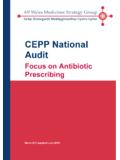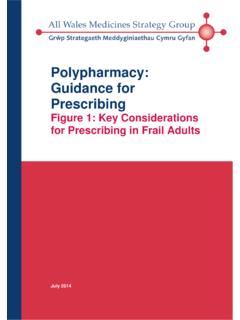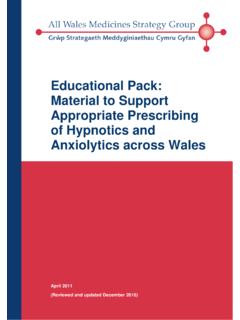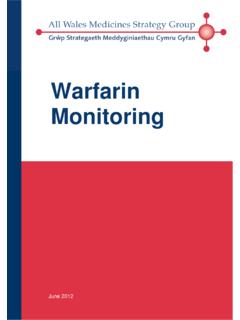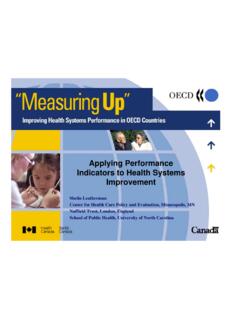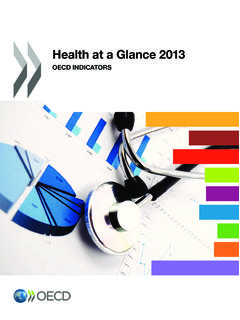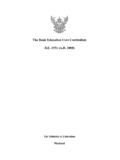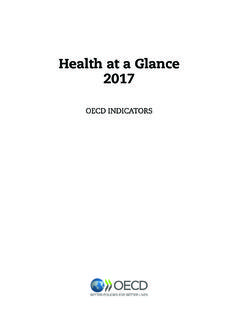Transcription of National Prescribing Indicators 2018–2019 - AWMSG
1 National Prescribing Indicators 2018 2019 Supporting Information for Prescribers February 2018 This report has been prepared by a multiprofessional collaborative group, with support from the All Wales Prescribing Advisory Group (AWPAG) and the All Wales Therapeutics and Toxicology Centre (AWTTC), and has subsequently been endorsed by the All Wales Medicines Strategy Group ( AWMSG ). Please direct any queries to AWTTC: All Wales Therapeutics and Toxicology Centre University Hospital Llandough Penlan Road Llandough Vale of Glamorgan CF64 2XX 029 2071 6900 This document should be cited as: All Wales Medicines Strategy Group, National Prescribing Indicators 2018 2019 : Supporting Information for Prescribers.
2 February 2018 . National Prescribing Indicators 2018 2019 Supporting Information for Prescribers Page 1 of 8 GLOSSARY ADQ average daily quantity ADRs adverse drug reactions AEC Anticholinergic Effect on Cognition AWMSG All Wales Medicines Strategy Group AWTTC All Wales Therapeutics and Toxicology Centre CEPP Clinical Effectiveness Prescribing Programme CHC combined hormonal contraceptive CKD chronic kidney disease DDD defined daily dose DVLA Driver and Vehicle Licensing Agency eGFR estimated glomerular filtration rate MHRA
3 Medicines and Healthcare products Regulatory Agency MRSA methicillin-resistant Staphylococcus aureus NICE National Institute for Health and Care Excellence NPH neutral protamine Hagedorn NPIs National Prescribing Indicators NSAIDs non-steroidal anti-inflammatory drugs PHW Public Health Wales PPIs proton pump inhibitors PPS Point Prevalence Survey PU Prescribing unit RCGP Royal College of General Practitioners SIGN Scottish Intercollegiate Guidelines Network SSRIs selective serotonin reuptake inhibitors STAR-PU specific therapeutic group age-sex related Prescribing unit WAPSU Welsh Analytical Prescribing Support Unit WeMeReC Welsh Medicines Resource Centre YCC Yellow Card Centre All Wales Medicines Strategy Group Page 2 of 8 SAFETY Indicators Prescribing SAFETY Indicators Purpose: To identify patients at high risk of ADRs and medicines-related harm in primary care.
4 Unit of measure: Number of patients with a peptic ulcer who have been prescribed NSAIDs without a PPI as a percentage of all patients. Number of patients with asthma who have been prescribed a beta-blocker as a percentage of all patients. Number of patients with concurrent prescriptions of verapamil and a beta-blocker as a percentage of all patients. Number of female patients with a past medical history of venous or arterial thrombosis who have been prescribed combined hormonal contraceptives, as a percentage of all female patients. Number of female patients with a current prescription of oestrogen-only hormone replacement therapy without any hysterectomy READ/SNOMED codes, as a percentage of all female patients.
5 Number of patients with concurrent prescriptions of warfarin and an oral NSAID as a percentage of all patients. Number of patients under 12 with a current prescription of aspirin as a percentage of all patients. Number of patients aged 65 years or over prescribed an NSAID plus aspirin and/or clopidogrel but without gastroprotection (PPI or H2 receptor antagonist), as a percentage of all patients aged 65 years or over. Number of patients aged 65 years or over prescribed an antipsychotic, as a percentage of all patients aged 65 years or over. Number of patients aged 75 and over with an AEC score of 3 or more for items on active repeat, as a percentage of all patients aged 75 and over.
6 Number of patients on the CKD register (CKD stage 3 5) who have received a repeat prescription for an NSAID within the last 3 months, as a percentage of all patients on the CKD register. Number of patients who are not on the CKD register but have an eGFR of < 59 ml/min and have received a repeat prescription for an NSAID within the last 3 months, as a percentage of all patients who are not on the CKD register but have an eGFR of < 59 ml/min. Why? This NPI is facilitating the move towards a more patient-focussed approach considering whether the right patients are getting the right medicines.
7 This is intended to reduce the number of ADRs experienced by patients. In the UK, it is estimated that around of hospital admissions are related to ADRs. ADRs can often be predictable, making it possible to identify potential causes and address them before actual patient harm occurs. Therefore a process of identifying patients electronically could enable intervention and help avoid harm. The PINCER study demonstrated that such an approach is an effective method for reducing the frequency of a range of medication errors. How? Review patients identified as being at high risk of ADRs and medicines-related harm.
8 No target has been set for the 2018 2019 NPI as this can provide a baseline for future years. Useful resources The Lancet (2012) PINCER study MHRA (2014) Antipsychotics learning module WeMeReC (2015) Medicines-related admissions AWMSG (2014) Polypharmacy: Guidance for Prescribing PrescQIPP (2016) Bulletin 140: Anticholinergic drugs AWMSG (2015) CEPP All Wales Audit: Towards Appropriate NSAID Prescribing AWMSG (2017) CEPP National Audit: Medicines Management for Chronic Kidney Disease (CKD) National Prescribing Indicators 2018 2019 Supporting Information for Prescribers Page 3 of 8 HYPNOTICS AND ANXIOLYTICS Purpose.
9 To encourage a reduction in the inappropriate Prescribing of hypnotics and anxiolytics in primary care. Unit of measure: Hypnotic and anxiolytic ADQs per 1,000 STAR-PUs. Why? There has been concern with regard to the high level of hypnotic and anxiolytic Prescribing in NHS Wales, with the substance misuse strategy of the Welsh Government (Working together to reduce harm) calling for the reduction of inappropriately prescribed benzodiazepines. The problems associated with benzodiazepines ( tolerance, dependence, withdrawal causing rebound insomnia) are well known, and the number of deaths associated with benzodiazepines has increased.
10 Hypnotics and anxiolytics are known to significantly increase the risk of falls. How? Hypnotics should only be considered after non-drug therapies have been explored. Hypnotics should be used in the lowest dose possible, for the shortest duration possible and in strict accordance with their licensed indications: no more than 4 weeks. Benzodiazepines should not be offered for the treatment of generalised anxiety disorder except as a short-term measure during crises. Consider reducing hypnotics and anxiolytics where appropriate. Useful resources AWMSG (2016) Educational Pack: Material to Support Appropriate Prescribing of Hypnotics and Anxiolytics across Wales AWMSG (2014) Polypharmacy: Guidance for Prescribing ANALGESICS TRAMADOL Purpose: To encourage the appropriate use and review of tramadol in primary care, minimising the potential for dependence, diversion, misuse and ADRs.
